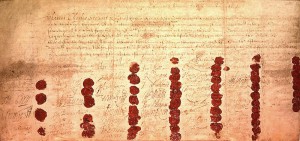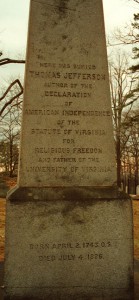 The Death Warrant of King Charles I, http://www.nationalarchives.gov.uk/pathways/citizenship/rise_parliament/docs/charles_warrant.htm
The Death Warrant of King Charles I, http://www.nationalarchives.gov.uk/pathways/citizenship/rise_parliament/docs/charles_warrant.htm
Millions of British citizens and their colonial counterparts across the Atlantic Ocean went to sleep on 2 September 1752 and woke up on 14 September. This shift in dates was due to an Act of Parliament passed in 1750, known as Chesterfield’s Act, which put into motion a series of changes that fundamentally altered the way that many measured time.
The calendar used by many nations around the world (including both Britain and America) was originally created by Julius Caesar in the year 45 B.C.[1] This calendar employed a system of 365 days spread out into 12 months with every fourth year having 366 days (a leap year). This calendar moved the first day of the year to January 1st from its original date of March 1st. However, when the Roman Empire fell in the 5th century, the calendar was once again realigned to coincide with Christian Festivals. By the 9th Century, some countries began celebrating the first day of the New Year on March 25 to coincide with Annunciation Day (the church holiday nine months prior to Christmas celebrating the Angel Gabriel’s revelation to the Virgin Mary that she was to be the mother of the Messiah).[2]
In 1582, Pope Gregory XIII introduced and recommended use of the Gregorian Calendar, which dropped ten days from October 1582 to correct issues regarding the dates of equinoxes and seasonal changes and re-established 1 January as the beginning of the calendar year.[3] However, several countries that rejected the authority of the Pope, including Britain, did not adopt the Gregorian Calendar, instead retaining the “Old Style” Julian Calendar.[4]
This discrepancy in dating systems led to a unique situation familiar to many genealogists. Given the differences in how certain governing bodies and independent citizens represented the date, a system known as dual or double dating was frequently applied.[5] In this system, the year was written using two consecutive digits at the end, separated by a ‘/’ or ‘–‘ (for example, 1727/28), as a means of representing the current date utilizing both dating systems. (This form was used for the disputed months between January and March; dates falling outside these months are regarded as belonging within their calendar year.) Dual dating was common on both formal and informal documents in many European countries and their colonies for centuries. The American colonies applied double dating to documents until 1752.[6]
In 1750, the British Parliament passed the Calendar (New Style) Act. The Act stated “The old supputation of the year not to be made use of after Dec. 1751. Year to commence for the future on 1 Jan. The days to be numbered as now until 2d Sept. 1752; and the day following to be accounted 14 Sept. omitting 11 days.”[7] Therefore, 1 January became the first day of the year 1752. Also, as noted in the introduction to this article, 2 September 1752 was followed by 14 September 1752, thus removing the eleven day difference created by the shift in dating systems.
 Gravestone of Thomas Jefferson, courtesy of Find A Grave, http://www.findagrave.com/cgi-bin/fg.cgi?page=gr&GRid=544
Gravestone of Thomas Jefferson, courtesy of Find A Grave, http://www.findagrave.com/cgi-bin/fg.cgi?page=gr&GRid=544
The dual dating system is often found by historians and genealogists in a variety of official documents, personal correspondence, and at times, in more permanent locations. The usage of the Julian Calendar prior to 1752 is a fact that historians must be aware of when conducting research, one example being the death warrant for King Charles I of England. During his reign, the High Court of Justice in England issued a warrant declaring Charles I guilty of many crimes, chief among them being treason. The document is dated 29 January 1648. However, since the new year began on 25 March according to the system utilized by the English at this time, this event would have taken place in the year 1649 based upon the modern calendar.[8]
While the Calendar (New Style) Act of 1750 effectively ended the use of double dating in the American colonies, the legacy of the dating system survived much longer. In the graveyard of the Monticello, the gravestone of Thomas Jefferson, third President of the United States, notes that his date of birth was “2 April 1743 O.S.” (Old Style), as Jefferson was born prior to the 1750 Act of Parliament.[9] The final nations to adopt the Gregorian calendar were Greece (1923) and the Soviet Union (1929).[10]
Notes
[1] ‘sclapp,’ “The 1752 Calendar Change” Connecticut State Library, 2011, http://www.ctstatelibrary.org/node/2218.
[2] Ibid.
[3] Wells, D. W. and R. F. Wells. 1910. A History of Hatfield Massachusetts, http://www.bio.umass.edu/biology/conn.river/calendar.html.
[4] ‘sclapp,’ “The 1752 Calendar Change” Connecticut State Library, 2011, http://www.ctstatelibrary.org/node/2218.
[5] Spathaky, Mike, “Old Style and New Style Dates and the Change to the Gregorian Calendar: A Summary for Genealogists,” GENUKI, http://www.cree.name/genuki/dates.htm.
[6] ‘sclapp,’ “The 1752 Calendar Change” Connecticut State Library, 2011, http://www.ctstatelibrary.org/node/2218.
[7] UK Legislation, Calendar (New Style) Act 1750, 1750 c. 23 (Regnal. 24_Geo_2), http://www.legislation.gov.uk/apgb/Geo2/24/23/contents.
[8] “Death warrant of Charles I: HLRO Main Papers (1660)” UK National Archives, http://www.nationalarchives.gov.uk/pathways/citizenship/rise_parliament/transcripts/charles_warrant.htm.
[9] Gravestone for Thomas Jefferson, Monticello Graveyard, Albemarle County, Virginia, Find A Grave Memorial #: 544, maintained by: Find A Grave.
[10] Heper, Metin, ed. The Routledge Handbook of Modern Turkey (Routledge, 2013), p. 54.
Share this:
About Zachary Garceau
Zachary J. Garceau is a former researcher at the New England Historic Genealogical Society. He joined the research staff after receiving a Master's degree in Historical Studies with a concentration in Public History from the University of Maryland-Baltimore County and a B.A. in history from the University of Rhode Island. He was a member of the Research Services team from 2014 to 2018, and now works as a technical writer. Zachary also works as a freelance writer, specializing in Rhode Island history, sports history, and French Canadian genealogy.View all posts by Zachary Garceau →